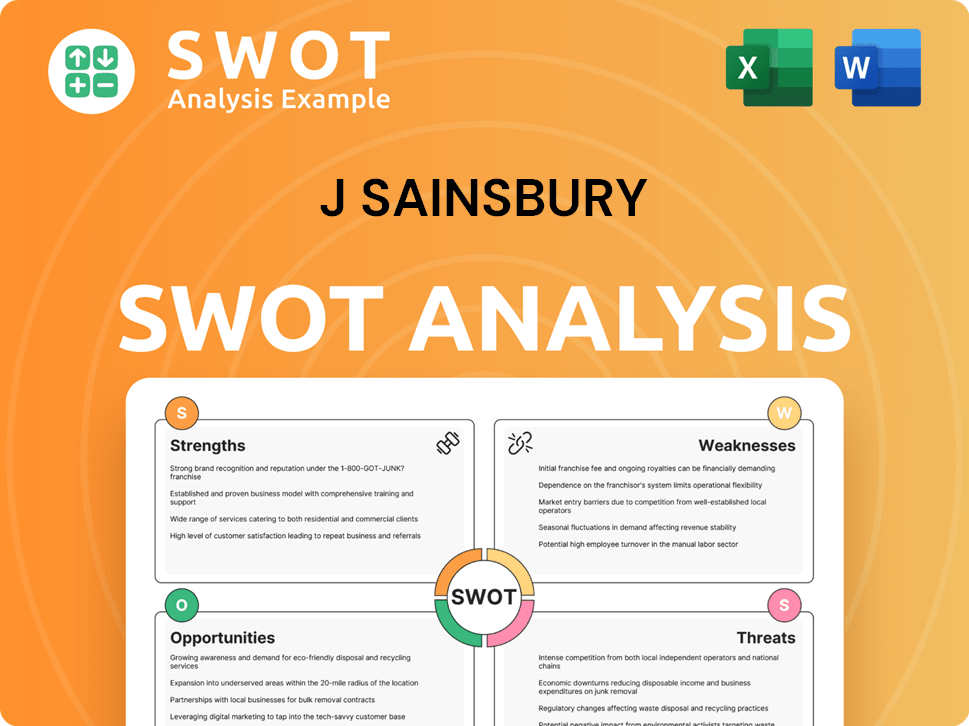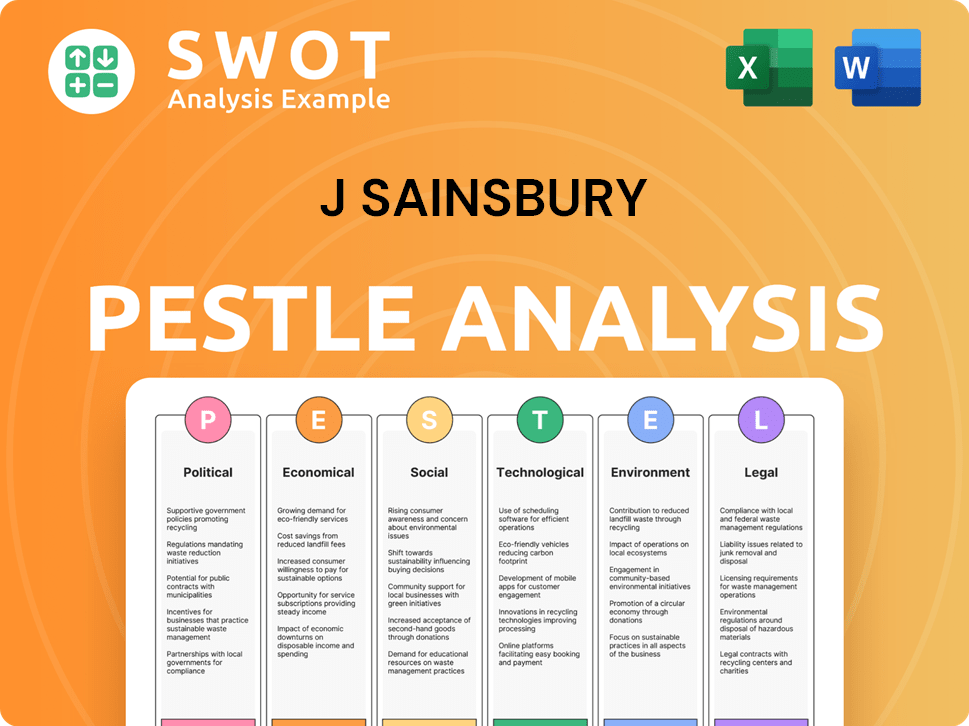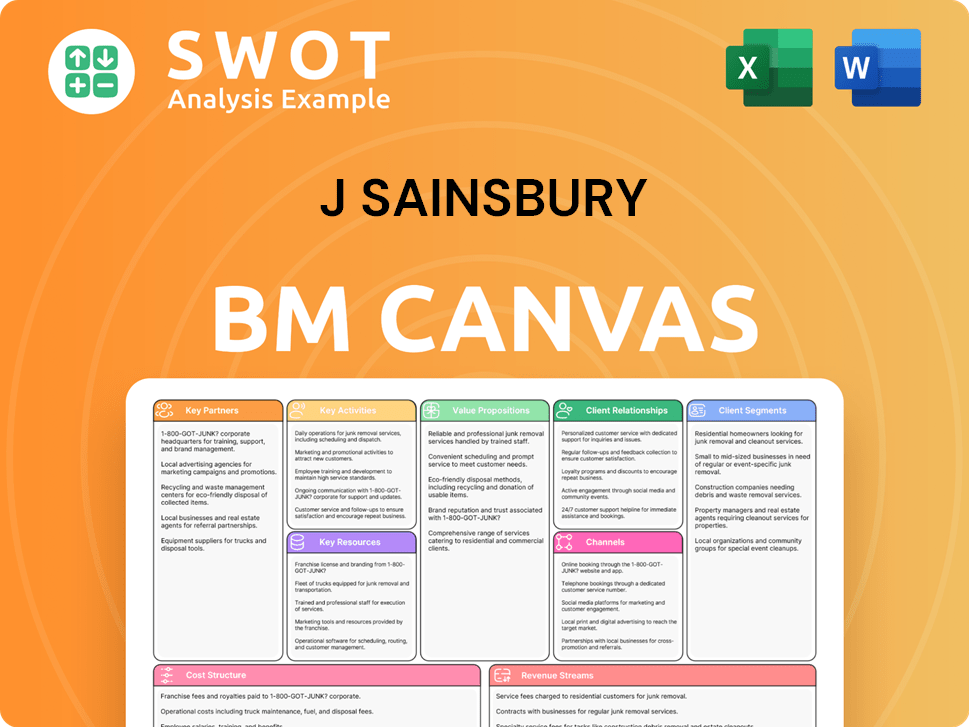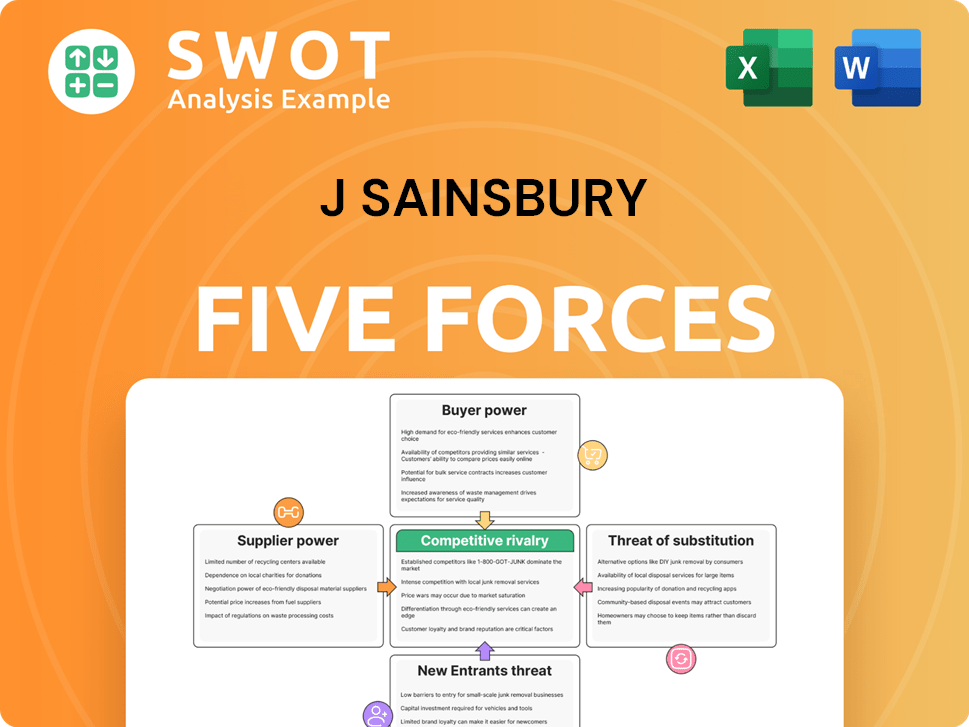J Sainsbury Bundle
Can Sainsbury's Navigate the UK Grocery Wars?
The UK grocery market is a battlefield, constantly reshaped by discounters, online giants, and evolving consumer demands. J Sainsbury plc, a cornerstone of British retail since 1869, is right in the thick of it. From its humble beginnings as a dairy shop, Sainsbury's has grown into a retail behemoth, but can it maintain its position?

This J Sainsbury SWOT Analysis explores the dynamic J Sainsbury competitive landscape, examining its key Sainsbury's competitors and strategic positioning within the Grocery market UK. We'll delve into Sainsbury's market analysis to understand its current standing, future prospects, and how it aims to compete in the ever-changing Retail industry analysis.
Where Does J Sainsbury’ Stand in the Current Market?
The core operations of J Sainsbury plc revolve around its extensive retail network, primarily focused on the grocery market in the UK. The company's value proposition centers on offering a wide range of high-quality products, including groceries, fresh produce, and general merchandise, through its supermarkets, convenience stores, and online platform. This is complemented by a strong emphasis on customer service and loyalty programs, aiming to provide a superior shopping experience.
Sainsbury's strategic focus includes maintaining a strong market position in the UK grocery sector, diversifying its offerings, and enhancing its digital capabilities to meet evolving consumer demands. The acquisition of Argos in 2016 expanded its general merchandise offerings, while investments in online grocery delivery and customer loyalty programs like Nectar Prices aim to boost customer retention and value perception. The company's 'Food First' strategy is designed to navigate inflationary pressures and maintain competitiveness within the retail industry.
As of February 2025, J Sainsbury held approximately 15.3% of the UK grocery market share, positioning it as the second-largest supermarket chain. This market share indicates a significant presence in the competitive landscape, reflecting its ability to attract and retain customers. Sainsbury's competitive advantages include its established brand, extensive store network, and diversified product offerings, which contribute to its strong market position. For a deeper understanding of their marketing strategies, consider exploring the Marketing Strategy of J Sainsbury.
Sainsbury's holds a significant market share in the UK grocery market. It ranks as the second-largest supermarket chain, behind Tesco. This position is a crucial indicator of its competitive strength and customer reach.
The company offers a broad range of products, including groceries, fresh produce, and general merchandise through Argos. This diversification helps Sainsbury's cater to a wide customer base. They also provide online grocery delivery services.
Sainsbury's has focused on digital transformation and customer loyalty. Initiatives like Nectar Prices aim to boost customer retention. The 'Food First' strategy helps manage inflationary pressures.
In the third quarter of fiscal year 2024/25, grocery sales increased by 9.3% and Argos sales grew by 4.9%. This indicates a solid financial performance. The company constantly benchmarks itself against industry averages and competitors.
Sainsbury's competitive advantages include a strong brand reputation, extensive store network, and diversified product offerings. These factors contribute to its ability to attract and retain customers in the competitive UK grocery market.
- Established Brand: A long-standing reputation for quality and customer service.
- Extensive Network: A wide network of supermarkets and convenience stores across the UK.
- Diversified Offerings: Includes groceries, fresh produce, and general merchandise through Argos.
- Digital Capabilities: Robust online platform and delivery services.
J Sainsbury SWOT Analysis
- Complete SWOT Breakdown
- Fully Customizable
- Editable in Excel & Word
- Professional Formatting
- Investor-Ready Format

Who Are the Main Competitors Challenging J Sainsbury?
The Revenue Streams & Business Model of J Sainsbury is significantly shaped by the competitive landscape within the UK retail sector. Understanding the key players and their strategies is crucial for assessing Sainsbury's market position and future prospects. This analysis focuses on identifying the primary and secondary competitors influencing Sainsbury's performance.
Sainsbury's faces intense competition across various segments, from grocery to general merchandise. The rise of discounters and the increasing dominance of online retail further complicate the competitive dynamics. This overview provides a comprehensive look at Sainsbury's key rivals and the challenges they pose.
The UK grocery market is highly competitive, with several major players vying for market share. Sainsbury's must navigate this environment to maintain its position and achieve sustainable growth. This section details the key competitors and their impact on Sainsbury's operations.
Tesco is Sainsbury's primary competitor, consistently holding the largest market share in the UK grocery market. Tesco's extensive store network, diverse product offerings, and loyalty programs like Clubcard give it a significant advantage. In 2024, Tesco's market share was around 27%, significantly higher than Sainsbury's.
Asda competes fiercely on price, often emphasizing its value proposition to attract budget-conscious consumers. Asda's focus on low prices and large store formats makes it a strong competitor, particularly in areas where price sensitivity is high. Asda's market share in 2024 was approximately 14%.
Morrisons focuses on fresh food and in-store butchers, differentiating itself from competitors with a strong emphasis on quality and in-house production. Morrisons' market share in 2024 was around 9%, competing directly with Sainsbury's in the premium grocery segment.
Aldi has rapidly gained market share by offering a limited range of products at highly competitive prices. Aldi's efficient operating model and aggressive expansion have made it a major disruptor in the UK grocery market. Aldi's market share in 2024 was approximately 10%.
Lidl also offers a limited range of products at highly competitive prices, similar to Aldi. Lidl's expansion and value proposition have made it a significant competitor, particularly for budget-conscious consumers. Lidl's market share in 2024 was around 8%.
Marks & Spencer competes in the premium grocery and general merchandise segments. M&S's focus on quality and brand reputation makes it a direct competitor in certain product categories. M&S's food sales in 2024 contributed significantly to its overall revenue.
Sainsbury's responds to competitive pressures through various strategies, including price adjustments, loyalty programs, and product innovation. The rise of online retail and the increasing importance of convenience have led Sainsbury's to invest in its online presence and delivery services.
- Pricing Strategies: Sainsbury's uses promotions and its Nectar Prices initiative to compete with discounters and other supermarkets.
- Loyalty Programs: The Nectar card helps Sainsbury's retain customers and gather valuable data for targeted marketing.
- Online Retail: Sainsbury's has expanded its online grocery delivery and click-and-collect services to compete with online retailers.
- Product Innovation: Sainsbury's focuses on offering a wide range of products, including premium and own-brand options, to differentiate itself.
J Sainsbury PESTLE Analysis
- Covers All 6 PESTLE Categories
- No Research Needed – Save Hours of Work
- Built by Experts, Trusted by Consultants
- Instant Download, Ready to Use
- 100% Editable, Fully Customizable

What Gives J Sainsbury a Competitive Edge Over Its Rivals?
Understanding the competitive landscape is crucial for evaluating the performance and future prospects of any company, including J Sainsbury. This analysis delves into the key competitive advantages that position the company within the UK grocery market. It examines how Sainsbury's differentiates itself from rivals through its brand, operational strategies, and customer-focused initiatives. A comprehensive understanding of these elements is essential for investors, analysts, and anyone interested in the retail sector.
Sainsbury's faces intense competition within the UK grocery market, with rivals like Tesco, Asda, and discounters such as Aldi and Lidl. The company's ability to maintain and enhance its market share depends on its capacity to leverage its strengths and adapt to changing consumer behaviors and market dynamics. This assessment highlights the strategies and competitive advantages that enable Sainsbury's to navigate this challenging environment. For more insights, you can explore the Owners & Shareholders of J Sainsbury.
The following sections will break down the specific advantages that Sainsbury's holds, providing a detailed view of its competitive positioning. This includes an examination of its brand equity, store network, online presence, supply chain efficiency, and customer loyalty programs. The goal is to provide a clear picture of how Sainsbury's competes and what makes it unique in the UK retail industry.
Sainsbury's benefits from a strong brand reputation built over more than 150 years. This long history has cultivated significant customer loyalty and trust, which is a key competitive advantage. This established brand recognition helps Sainsbury's attract and retain customers in a competitive market.
Sainsbury's operates a vast network of supermarkets and convenience stores across the UK. This widespread presence ensures accessibility for a large customer base. The physical store network is a crucial element of Sainsbury's competitive strategy, providing convenience and reach.
The Nectar loyalty program, shared with Argos, is a significant driver of customer loyalty. It offers personalized discounts and rewards, encouraging repeat purchases and data-driven marketing. This program helps Sainsbury's gather valuable customer data and tailor its offerings.
Sainsbury's has a robust online platform for groceries and general merchandise, including click-and-collect and home delivery options. The integration of Argos within Sainsbury's stores and online channels enhances convenience and expands product accessibility. This omnichannel approach is vital in today's retail environment.
Sainsbury's competitive advantages include a strong brand, extensive store network, and a robust online platform. These strengths are supported by efficient supply chain management and customer loyalty programs. The company's focus on product quality and sustainability further enhances its market position.
- Brand Heritage: Over 150 years of brand building fosters customer trust and loyalty.
- Store Network: Extensive physical stores provide wide geographic reach.
- Online Presence: A strong online platform with click-and-collect and home delivery options.
- Loyalty Programs: Nectar program drives repeat purchases and data-driven marketing.
- Supply Chain: Efficient procurement and distribution, contributing to cost advantages.
J Sainsbury Business Model Canvas
- Complete 9-Block Business Model Canvas
- Effortlessly Communicate Your Business Strategy
- Investor-Ready BMC Format
- 100% Editable and Customizable
- Clear and Structured Layout

What Industry Trends Are Reshaping J Sainsbury’s Competitive Landscape?
The J Sainsbury competitive landscape is shaped by dynamic industry trends, presenting both challenges and opportunities. The UK grocery market is undergoing significant transformation, driven by technological advancements, changing consumer preferences, and intense competition. Understanding these factors is crucial for Sainsbury's market analysis and strategic planning.
Sainsbury's market share 2024 reflects its position amidst fierce rivalry. The company faces pressure from established players and emerging discounters. Successful navigation of this landscape requires strategic agility and a focus on customer value. The future of Sainsbury's in the UK market depends on its ability to adapt and innovate.
The retail industry analysis reveals significant shifts. E-commerce and rapid delivery services are growing rapidly, requiring substantial investment in digital infrastructure. Sustainability and ethical sourcing are increasingly important to consumers, influencing product offerings. The ongoing cost-of-living crisis continues to affect consumer spending habits.
Supermarket competition remains intense, with discounters like Aldi and Lidl expanding their market presence. Regulatory changes, such as new environmental or labor laws, could increase operational costs. Adapting to evolving consumer preferences and maintaining competitive pricing strategies are critical challenges. Anticipated disruptions include new market entrants leveraging innovative technologies.
Enhancing the personalized customer experience through data analytics presents a significant opportunity. Expanding into underserved regional markets and exploring Sainsbury's strategic partnerships can drive growth. Leveraging the Argos acquisition to integrate general merchandise and grocery loyalty programs offers cross-promotional benefits. The company can capitalize on increasing demand for sustainable products.
Who are Sainsbury's main rivals? The company competes with Tesco, Asda, Morrisons, and discounters like Aldi and Lidl. Sainsbury's vs Tesco comparison often highlights strengths in brand positioning and customer loyalty. Understanding these dynamics is crucial for strategic decision-making. The company must continually evaluate its competitive advantages of Sainsbury's.
Sainsbury's financial performance review indicates the need for ongoing operational efficiency and strategic investments. The company must address the Impact of online grocery on Sainsbury's, optimizing its digital presence and delivery capabilities. A robust Sainsbury's SWOT analysis is vital. For example, in 2024, the focus will be on Sainsbury's supply chain analysis to ensure efficiency and reduce costs.
- Sainsbury's pricing strategy analysis, including the Nectar Prices initiative, is crucial to maintain competitiveness.
- Sainsbury's customer loyalty programs play a key role in retaining customers and driving sales.
- Sainsbury's expansion plans, including potential acquisitions or market entries, should be carefully evaluated.
- Sainsbury's brand positioning, emphasizing quality and value, must be consistently reinforced.
For further insights into Sainsbury's market analysis and strategic direction, consider the insights provided in the Growth Strategy of J Sainsbury.
J Sainsbury Porter's Five Forces Analysis
- Covers All 5 Competitive Forces in Detail
- Structured for Consultants, Students, and Founders
- 100% Editable in Microsoft Word & Excel
- Instant Digital Download – Use Immediately
- Compatible with Mac & PC – Fully Unlocked

Related Blogs
- What are Mission Vision & Core Values of J Sainsbury Company?
- What is Growth Strategy and Future Prospects of J Sainsbury Company?
- How Does J Sainsbury Company Work?
- What is Sales and Marketing Strategy of J Sainsbury Company?
- What is Brief History of J Sainsbury Company?
- Who Owns J Sainsbury Company?
- What is Customer Demographics and Target Market of J Sainsbury Company?
Disclaimer
All information, articles, and product details provided on this website are for general informational and educational purposes only. We do not claim any ownership over, nor do we intend to infringe upon, any trademarks, copyrights, logos, brand names, or other intellectual property mentioned or depicted on this site. Such intellectual property remains the property of its respective owners, and any references here are made solely for identification or informational purposes, without implying any affiliation, endorsement, or partnership.
We make no representations or warranties, express or implied, regarding the accuracy, completeness, or suitability of any content or products presented. Nothing on this website should be construed as legal, tax, investment, financial, medical, or other professional advice. In addition, no part of this site—including articles or product references—constitutes a solicitation, recommendation, endorsement, advertisement, or offer to buy or sell any securities, franchises, or other financial instruments, particularly in jurisdictions where such activity would be unlawful.
All content is of a general nature and may not address the specific circumstances of any individual or entity. It is not a substitute for professional advice or services. Any actions you take based on the information provided here are strictly at your own risk. You accept full responsibility for any decisions or outcomes arising from your use of this website and agree to release us from any liability in connection with your use of, or reliance upon, the content or products found herein.